Passenger arrivals and visitors
Published 25 August 2016
Valid: 25 August 2016 to 30 November 2016
This topic includes information on passenger arrivals, visitors and visas. Passenger arrivals data for non-European Economic Area (EEA) nationals are based on landing cards completed as people cross the border and measure the number of arrivals. Visa data relate to grants of visas applied for outside the UK. More information on non-visitor arrival and visa data by reason and nationality is included in the Work topic, Study topic and Family topic.
Back to ‘Immigration statistics April to June 2016’ content page.
This is not the latest release. View latest release.
1. Key facts
The total number of passenger arrivals increased by 4% to a record 125.2 million in the year ending June 2016 (+4.7 million). This increase was accounted for by 4.4 million more arrivals by British, other EEA and Swiss nationals (up 4% to 110.0 million) and 0.3 million more arrivals by non-EEA nationals (up 2% to 15.2 million), compared with the previous 12 months. These numbers represent the number of occasions when a person entered the UK, not the number of distinct individuals.
Data for the calendar year 2015 show total number of passenger arrivals increased by 5% to 123.3 million. This increase was accounted for by 4.9 million more arrivals by British nationals (up 7% to 72.4 million), 0.7 million more arrivals by other EEA and Swiss nationals (up 2% to 35.7 million) and 0.6 million more arrivals by non-EEA nationals (up 4% to 15.3 million), compared with 2014.
The number of non-EEA visitors increased by 3% (+0.3 million). Over a quarter (29%) of all non-EEA visitor arrivals were made by United States nationals.
There were 16,147 (-1%) fewer visitor visas granted to citizens of non-EEA countries in the year ending June 2016 at around 1.9 million. There were notable increases in visitor visas granted to Chinese nationals, up 18% (+64,758 to 432,251, excluding Hong Kong), and Indian nationals, up 6% (+19,836 to 376,499).
2. Passenger arrivals
The diagram below illustrates the type and volume of arrivals in 2015.
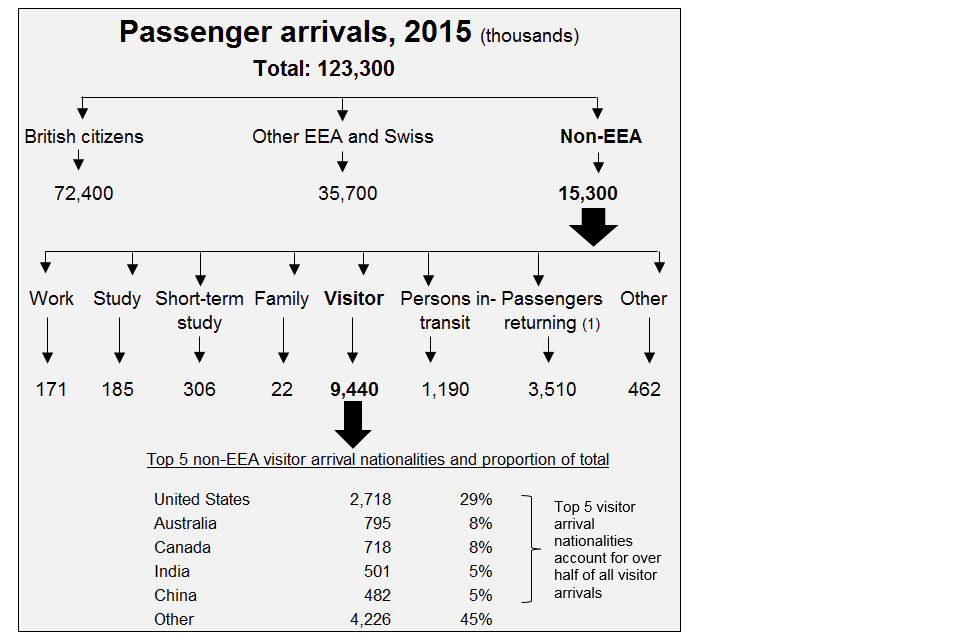
Chart notes
Source: Home Office, Immigration Statistics April to June 2016, Admissions tables ad 01, ad 02 and ad 03 o.
(1) Passengers returning are people who have previously arrived in the UK on a non-visit visa, including people who came in the current and previous years and people who are long term residents in the UK. They include those settled in the UK and who have been absent for less than two years (who do not need a visa), and those subject to a limited leave to enter (such as workers or students) who have returned within the time limit of that leave. Their initial arrival will have been counted in one of the specific arrival categories in the relevant time period.
Long-term trends in passenger arrivals
The chart below illustrates longer-term trends in passengers entering the UK by calendar year.

Chart notes
Source: Home Office, Immigration Statistics April to June 2016, Admissions table ad 01.
Passenger arrivals (non-EEA nationals) by purpose of journey
| 2011 | 2012 | 2013 | 2014 | 2015 | Change: latest year | Percentage change | |
|---|---|---|---|---|---|---|---|
| Total arrivals (thousands) | 13,300 | 12,900 | 14,000 | 14,600 | 15,300 | +639 | +4% |
| of which: | |||||||
| Work | 149 | 143 | 156 | 163 | 171 | +7 | +5% |
| Study (excl short term) | 267 | 211 | 199 | 193 | 185 | -8 | -4% |
| Short-term study (2) | 262 | 299 | 263 | 280 | 306 | +27 | +10% |
| Family | 38 | 32 | 23 | 22 | 22 | -0.2 | -1% |
| Visitors | 7,910 | 7,690 | 8,690 | 9,160 | 9,440 | +285 | +3% |
| Persons in-transit | 1,130 | 1,100 | 1,190 | 1,200 | 1,190 | -7 | -1% |
| Passengers returning (1) | 3,280 | 3,130 | 3,130 | 3,240 | 3,507 | +270 | +8% |
| Other | 293 | 313 | 351 | 398 | 462 | +64 | +16% |
Table notes
Source: Home Office, Immigration Statistics April to June 2016, Admissions table ad 01.
(1) Passengers returning are people who have previously arrived in the UK on a non-visit visa. They include those settled in the UK and who have been absent for less than two years, and those subject to a limited leave to enter who have returned within the time limit of that leave. Their initial arrival will have been c
ounted in one of the specific arrival categories in the relevant time period.
(2) The Short-term study category (previously described as ‘Student visitor’) allows individuals to come to the UK for 6 months (or 11 months if they will be studying an English Language course) and cannot extend their stay (further details at Short-term study visa and the Study section).
For both visitors and short-term study, non-visa nationals do not require a visa for visits of up to 6 months, so total figures for arrivals are not directly comparable with total visitor or student visitor visas.
3. Visitors (non-EEA)
In 2015, there were 9.4 million visitor arrivals. Of the 9.4 visitor arrivals, over three-quarters (82%; 7.7 million) were for ‘ordinary’ visitors and 18% (1.7 million) were arrivals by business visitors. Passengers are counted each time they enter the UK. Where an individual enters more than once in a period they will be counted each time they enter. The numbers of visitors admitted to the UK remained stable from 2004 to 2010, after which ordinary visitors increased from 5.5 million in 2010 to 7.5 million in 2014 (+36%). The number of business visitors has remained flat over this period.
In the year ending June 2016, there were 2.2 million visitor visa applications (up 2%) and 1.9 million were granted (down 1%). Of the 1.9 million visitor visas granted, 84% (1.6 million) were to ‘ordinary’ visitors and 16% (0.3 million) were to ‘business-related’ visitors, a very similar breakdown to visitor arrivals.
Visitor arrivals are much higher than the number of visitor visas granted as ‘non-visa nationals’ (for example nationals of the United States, Brazil and Japan) do not need a visa to come to the UK for a visit of less than six months. Visa nationals must obtain a visa before travelling to the UK, except in certain circumstances, unless they are returning residents or those with permission to stay who are returning after a temporary absence. A non-visa national does not normally need a visa to visit the UK for less than six months, unless it is a requirement of the immigration category under which they are entering – e.g. to ‘work’ in the UK. Any non-visa national coming to the UK for more than six months will need a visa. Omani, Qatari and UAE nationals were able to visit the UK without a visa from 1 January 2014 (the Electronic Visa Waiver scheme was introduced on 1 January 2014 resulting in significant falls for these nationalities). This scheme was extended to Kuwaiti nationals from 21 February 2016. Those arriving with an Electronic Visa Waiver are included in the visa national visitor arrivals but are excluded from visitor visas granted as they would not have been granted a visa to travel as a visitor.
The chart below shows a similar trend in visitor arrivals and visitor visas granted for visa nationalities. The ratio of visitor arrivals to visitor visas granted has increased steadily over time. The volume of visitor arrivals for visa nationals is higher than visitor visas granted, likely owing to the fact that visitors could ‘arrive’ in the UK on multiple occasions over the period that their visa is valid for. Non-visa national visitor arrivals are much higher in volume but have also followed a similar trend since 2005 with increases since year ending 2009.
Long-term trends in visitor arrivals and visitor visas granted (visa nationals only)

Chart notes
Source: Home Office, Immigration Statistics April to June 2016, Visas table vi 06 q, Visas vol. 3 and Admissions ad 03 o.
3.1 Duration of visitor visas
Visit visas are usually issued for up to a maximum of 6 months (or in some cases, up to a maximum of 12 months). Visit visas with a longer duration of validity (of 2, 5 or 10 years) can be issued to those who need to visit the UK regularly over a longer period and allow stays of up to a maximum of 6 months on each visit.
Of the 1.9 million visitor visas granted in the year ending June 2016, 76% (1.4 million) were for up to 6 months and 24% (0.5 million) were longer-term visit visas.
3.2 Trends in visitor visas and arrivals by nationality
There were 1,884,687 visitor visas granted in the year ending June 2016, a decrease of 1% (-16,147) compared with the year ending June 2015. Excluding Kuwaiti nationals, who were able to visit the UK without a visa from 21 February 2016 as part of the Electronic Visa Waiver scheme, the number of visitor visas granted increased by 1% (+11,040) to 1,824,006.
There were notable increases in visitor visa grants for Chinese nationals, up 18% (+64,758 to 432,251, excluding Hong Kong), and Indian nationals, up 6% (+19,836 to 376,499). By contrast there were large falls in visitor visa grants for Russian nationals (-35,056 to 94,874), down 27%. The diagram below illustrates the latest trends in visitor visas granted.
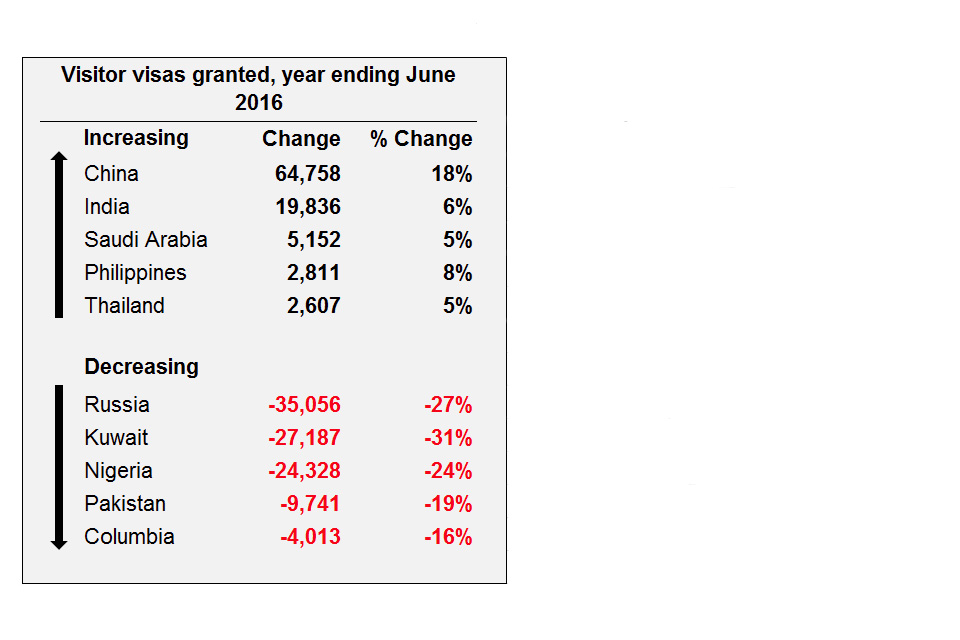
Table notes
Source: Home Office, Immigration statistics April to June 2016, Visas table vi 06 q o, Visas vol. 3.
Omani, Qatari and UAE nationals were able to visit the UK without a visa from 1 January 2014 (the Electronic Visa Waiver scheme was introduced on 1 January 2014 resulting in significant falls for these nationalities). This scheme was extended to Kuwaiti nationals from 21 February 2016, which also resulted in significant falls for this nationality in the year ending June 2016.
There were 9.4 million visitor arrivals in 2015, an increase of 3% (+0.3 million) compared with 2014. The map below shows the top 10 visitor arrival nationalities in 2015.
Top 10 visitor arrivals, 2015
(Total 9.4 million)
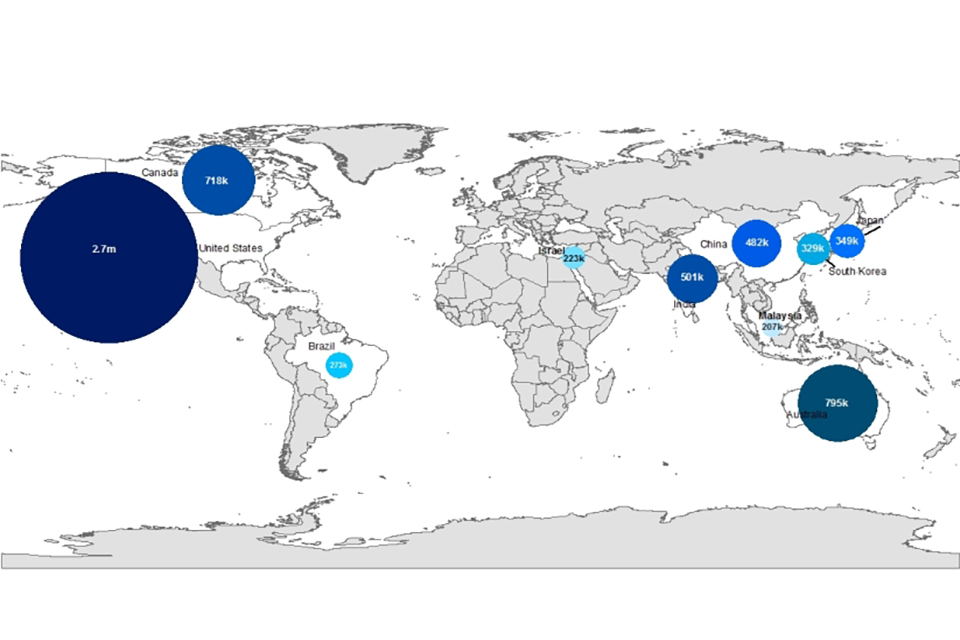
Chart notes
Source: Home Office, Immigration Statistics April to June 2016, Admissions table ad 03 o.
(1) China excludes Hong Kong.
Arrivals from US nationals, the largest nationality for visitors to the UK, increased by 4% (+100,000) and arrivals from Brazilian nationals decreased by 12% (-39,000). Nationals from these countries do not need a visa to visit the UK for up to 6 months. The diagram below illustrates the latest trends in visitor arrivals.
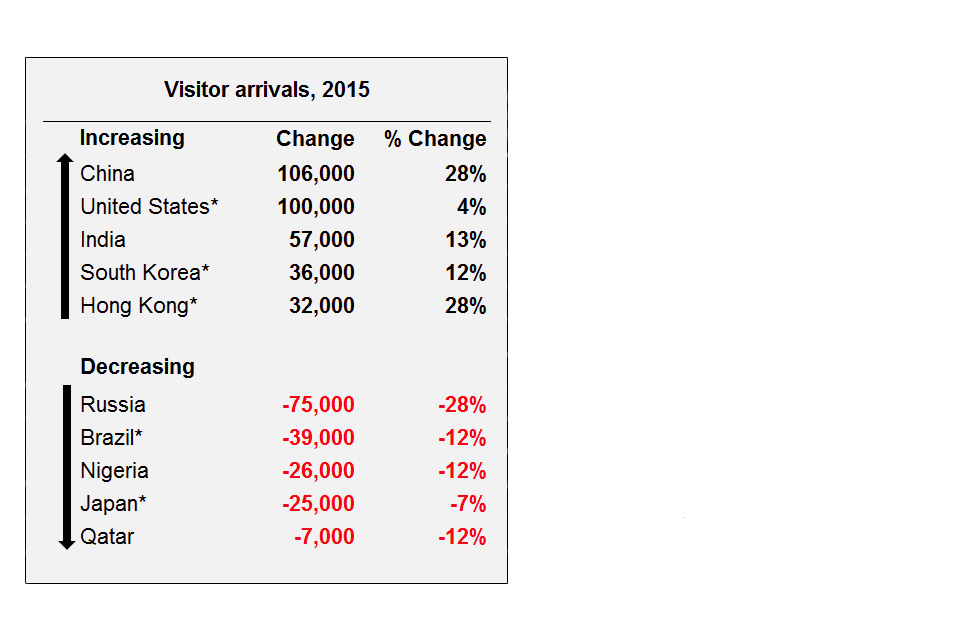
Table notes
Source: Home Office, Immigration Statistics April to June 2016, Admissions table ad 03 o.
Omani, Qatari and UAE nationals were able to visit the UK without a visa from 1 January 2014 (the Electronic Visa Waiver scheme was introduced on 1 January 2014 resulting in significant falls for these nationalities). This scheme was extended to Kuwaiti nationals from 21 February 2016.
* Non-visa national country. Nationals from these countries do not need a visa to visit the UK for stays of up to 6 months.
4. Visas
The following diagram illustrates the type and volume of visas granted in the year ending June 2016. The volume of visas granted is much lower than non-EEA arrivals as some nationalities do not need a visa (for a visit of six months or less) to enter the UK.
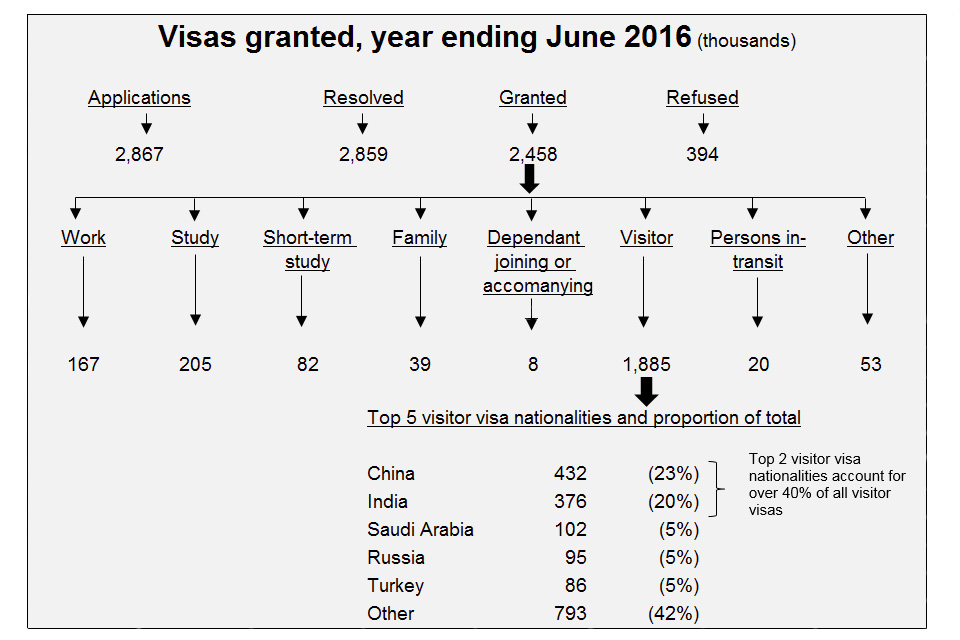
Chart notes
Source: Home Office, Immigration Statistics April to June 2016, Visas table vi 01 q and Visas table vi 06 q o.
5. Data tables
Further data on arrivals are available in Admissions tables ad 01 to ad 04.
Further data on entry clearance visas and sponsored visa applications for the work, study and family routes (described further in the Work topic, Study topic and Family topic) can be found in the following tables:
Visas vol. 1: tables vi 01 q to vi 05 q
The following tables are included in this volume:
vi 01 q Entry clearance visa applications and resolution by category
vi 02 q Entry clearance visa applications and resolution by country of nationality
vi 03 Entry clearance visa applications by country of nationality
vi 04 Entry clearance visas granted by category
vi 04 q Entry clearance visas granted by category
vi 5 Entry clearance visas granted by country of nationality
vi 5 q Entry clearance visas granted by country of nationality
Visas vol. 2: tables vi 06 q and vi 06 q w
The following tables are included in this volume:
vi 06 q Entry clearance visas granted by category and country of nationality: Summary
vi 06 q w Entry clearance visas granted by category and country of nationality: Work
Visas vol. 3: tables vi 06 q s to vi 06 q o
The following tables are included in this volume:
vi 06 q s Entry clearance visas granted by category and country of nationality: Study
vi 06 q f Entry clearance visas granted by category and country of nationality: Family
vi 06 q d Entry clearance visas granted by category and country of nationality: Dependant joining or accompanying
vi 06 q o Entry clearance visas granted by category and country of nationality: Other
Sponsorship: tables cs 01 to cs 14 q
6. Background information
This section relates to:
Grants of entry clearance visas to individuals outside the UK. Data include dependants and exclude visitor and transit visas unless stated otherwise;
The number of arrivals by people entering the UK. Where an individual enters the country more than once, each arrival is counted. For non-EEA nationals who are subject to immigration control, more detailed information is available on their nationality and purpose of their journey.
